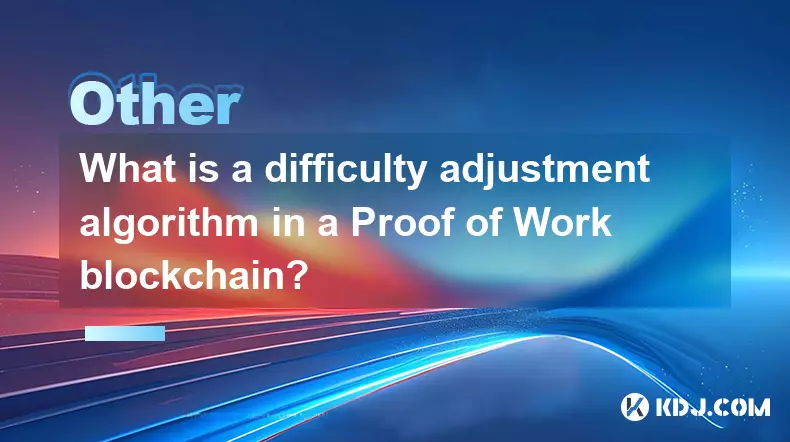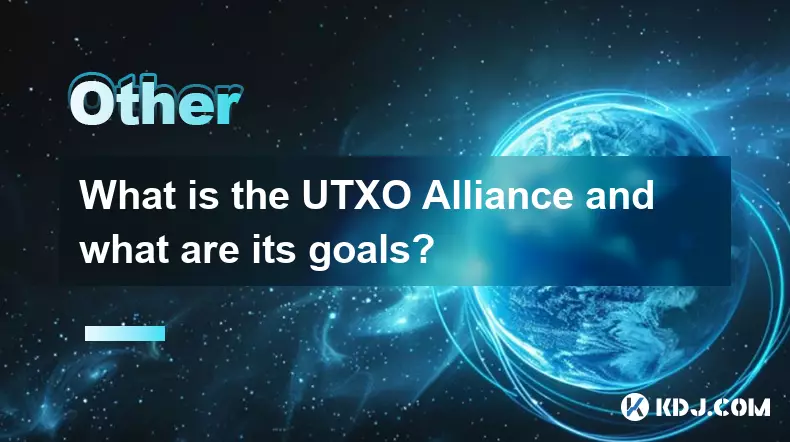-
 bitcoin
bitcoin $101752.865364 USD
-1.09% -
 ethereum
ethereum $3382.985899 USD
-1.38% -
 tether
tether $0.999658 USD
0.04% -
 xrp
xrp $2.272505 USD
-1.51% -
 bnb
bnb $989.089004 USD
0.14% -
 solana
solana $156.962612 USD
-3.08% -
 usd-coin
usd-coin $0.999776 USD
0.01% -
 tron
tron $0.290786 USD
-0.69% -
 dogecoin
dogecoin $0.174594 USD
-2.86% -
 cardano
cardano $0.560085 USD
-3.55% -
 hyperliquid
hyperliquid $40.023704 USD
-5.75% -
 chainlink
chainlink $15.324649 USD
-2.78% -
 bitcoin-cash
bitcoin-cash $493.576540 USD
-3.52% -
 zcash
zcash $571.320038 USD
-12.05% -
 stellar
stellar $0.280066 USD
-4.26%
What is a difficulty adjustment algorithm in a Proof of Work blockchain?
Difficulty adjustment in Proof of Work ensures consistent block times by automatically scaling mining difficulty, maintaining network stability and security despite fluctuating hash power.
Nov 09, 2025 at 08:20 am

Understanding the Role of Difficulty Adjustment in Proof of Work
1. A difficulty adjustment algorithm is a core mechanism in Proof of Work (PoW) blockchains that ensures blocks are mined at consistent intervals despite fluctuating network hash power. Without such a system, mining times would vary wildly as more miners join or leave the network.
2. The primary goal is to maintain a stable block production rate. For example, Bitcoin targets one block every ten minutes. If miners solve puzzles too quickly, the network automatically increases the mining difficulty to slow things down.
3. Conversely, if the time between blocks grows too long due to reduced hash power, the algorithm reduces the difficulty to keep the pace steady. This self-regulating feature preserves the predictability and security of the blockchain’s transaction timeline.
4. Difficulty adjustments occur at predefined intervals. In Bitcoin, this happens every 2016 blocks, roughly every two weeks. The algorithm evaluates how long it took to mine the previous set of blocks and recalibrates accordingly.
5. The mathematical formula compares actual block times against expected times. If blocks were mined faster than ten minutes on average, the new difficulty will rise proportionally. If slower, it drops. This keeps the blockchain resilient against external shifts in computational power.
How the Algorithm Maintains Network Stability
1. The consistency enforced by the difficulty adjustment prevents congestion and delays in transaction confirmations. Users can rely on predictable confirmation windows because the network adapts to changes in processing capacity.
2. Sudden spikes in mining activity—such as when large mining farms come online—could flood the network with blocks. The algorithm counters this by raising the bar for what constitutes a valid solution, restoring balance.
3. During periods of declining interest or increased electricity costs, miners may shut down operations. The drop in competition could delay block creation, but the algorithm responds by lowering difficulty, ensuring continuity.
4. This dynamic response protects against centralization risks. If difficulty remained fixed, only well-resourced miners could sustain operations during high-competition phases, pushing out smaller participants. Adjustments help level the playing field over time.
5. The transparency of the rule-based system fosters trust. Every node independently verifies the correctness of each difficulty change, reinforcing decentralization and reducing reliance on centralized oversight.
Examples of Difficulty Adjustment Across Blockchains
1. Bitcoin uses an algorithm that adjusts difficulty every 2016 blocks based on the total time taken to mine those blocks. If that period is shorter than two weeks, difficulty increases; if longer, it decreases.
2. Litecoin follows a similar model but with faster block times—2.5 minutes—requiring more frequent adjustments to maintain precision in its mining schedule.
3. Ethereum, before transitioning to Proof of Stake, used a variant called “difficulty bomb” alongside regular adjustments to incentivize the move away from mining. The bomb gradually made mining harder over time regardless of hash power.
4. Some altcoins implement continuous difficulty adjustment, recalculating after every single block. This approach minimizes variance and provides tighter control over block intervals.
5. Monero employs a unique rolling average method, calculating difficulty using the median of the last 60 blocks. This resists manipulation attempts and stabilizes mining even under volatile conditions.
Frequently Asked Questions
What happens if no difficulty adjustment existed?Without difficulty adjustment, block times would become erratic. Increased mining power would lead to rapid block creation, potentially overwhelming nodes. Reduced power would cause long delays, making transactions unreliable and harming user experience.
Can difficulty adjustments prevent 51% attacks?While not designed specifically for attack prevention, difficulty adjustments indirectly influence security. After a sudden drop in hash power, lower difficulty could make attacks cheaper. However, honest nodes continuing to validate protect the chain's integrity through consensus rules.
Who controls the difficulty adjustment parameters?No individual or group controls it. The algorithm is hardcoded into the protocol. Changes require broad consensus among developers, miners, and node operators, typically achieved through soft or hard forks approved by the community.
Is difficulty adjustment unique to cryptocurrency?The concept isn’t exclusive to crypto, but its implementation in PoW blockchains is distinctive. Other systems may regulate workload, but the decentralized, automated, and transparent nature of blockchain difficulty adjustment sets it apart from traditional computing models.
Disclaimer:info@kdj.com
The information provided is not trading advice. kdj.com does not assume any responsibility for any investments made based on the information provided in this article. Cryptocurrencies are highly volatile and it is highly recommended that you invest with caution after thorough research!
If you believe that the content used on this website infringes your copyright, please contact us immediately (info@kdj.com) and we will delete it promptly.
- Ripple (XRP) in 2026: Hold or Fold? A Look at XRP's Future and Emerging DeFi Alternatives
- 2025-11-08 18:35:01
- Zcash ZEC Coin Price Explosion: From Privacy Niche to Center Stage
- 2025-11-08 18:55:01
- Berachain Price Prediction: Navigating the Honeycomb Hype in Crypto
- 2025-11-08 18:55:01
- Arthur Hayes, Gold, and Bitcoin: A Modern Monetary Trinity?
- 2025-11-08 19:15:01
- Shiba Inu's Next Move: Navigating a Shifting Market
- 2025-11-08 19:20:01
- Pakistan's Crypto Crossroads: Balancing Opportunity with Asset-Backed Realities
- 2025-11-08 19:20:01
Related knowledge

What are intents in crypto and how do they change user interaction?
Nov 09,2025 at 09:00am
Understanding the Role of Decentralized Exchanges in Modern Crypto Trading1. Decentralized exchanges, commonly known as DEXs, have reshaped how trader...

What is restaking and how does it enhance economic security?
Nov 09,2025 at 11:40pm
Understanding Restaking in the Blockchain Ecosystem1. Restaking refers to the process where users who have already staked their tokens in a proof-of-s...

What is a cryptographic nonce and how is it used to prevent replay attacks?
Nov 08,2025 at 05:00pm
Understanding Cryptographic Nonces in Blockchain Systems1. A cryptographic nonce is a number used only once within a specific cryptographic communicat...

What are the trade-offs between liveness and safety in a consensus protocol?
Nov 09,2025 at 12:20pm
Understanding the Role of Liquidity Pools in Decentralized Finance1. Liquidity pools are foundational components within decentralized exchanges (DEXs)...

What is a call data in an Ethereum transaction and how is it used?
Nov 09,2025 at 01:59am
Understanding Call Data in Ethereum Transactions1. Call data refers to the information sent along with a transaction on the Ethereum network that spec...

What is the UTXO Alliance and what are its goals?
Nov 09,2025 at 01:39pm
Understanding the UTXO Alliance1. The UTXO Alliance is a collaborative initiative formed by prominent blockchain projects and developers who support t...

What are intents in crypto and how do they change user interaction?
Nov 09,2025 at 09:00am
Understanding the Role of Decentralized Exchanges in Modern Crypto Trading1. Decentralized exchanges, commonly known as DEXs, have reshaped how trader...

What is restaking and how does it enhance economic security?
Nov 09,2025 at 11:40pm
Understanding Restaking in the Blockchain Ecosystem1. Restaking refers to the process where users who have already staked their tokens in a proof-of-s...

What is a cryptographic nonce and how is it used to prevent replay attacks?
Nov 08,2025 at 05:00pm
Understanding Cryptographic Nonces in Blockchain Systems1. A cryptographic nonce is a number used only once within a specific cryptographic communicat...

What are the trade-offs between liveness and safety in a consensus protocol?
Nov 09,2025 at 12:20pm
Understanding the Role of Liquidity Pools in Decentralized Finance1. Liquidity pools are foundational components within decentralized exchanges (DEXs)...

What is a call data in an Ethereum transaction and how is it used?
Nov 09,2025 at 01:59am
Understanding Call Data in Ethereum Transactions1. Call data refers to the information sent along with a transaction on the Ethereum network that spec...

What is the UTXO Alliance and what are its goals?
Nov 09,2025 at 01:39pm
Understanding the UTXO Alliance1. The UTXO Alliance is a collaborative initiative formed by prominent blockchain projects and developers who support t...
See all articles





















![The Graph Price Prediction [GRT Crypto Price News Today] The Graph Price Prediction [GRT Crypto Price News Today]](/uploads/2025/11/07/cryptocurrencies-news/videos/690d4df44fe69_image_500_375.webp)




















































